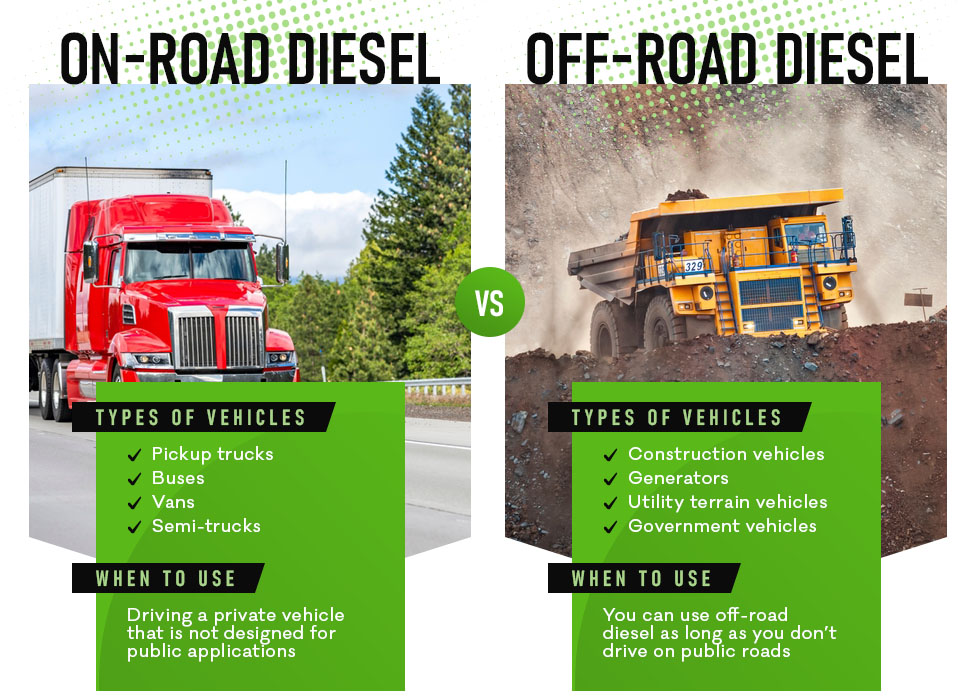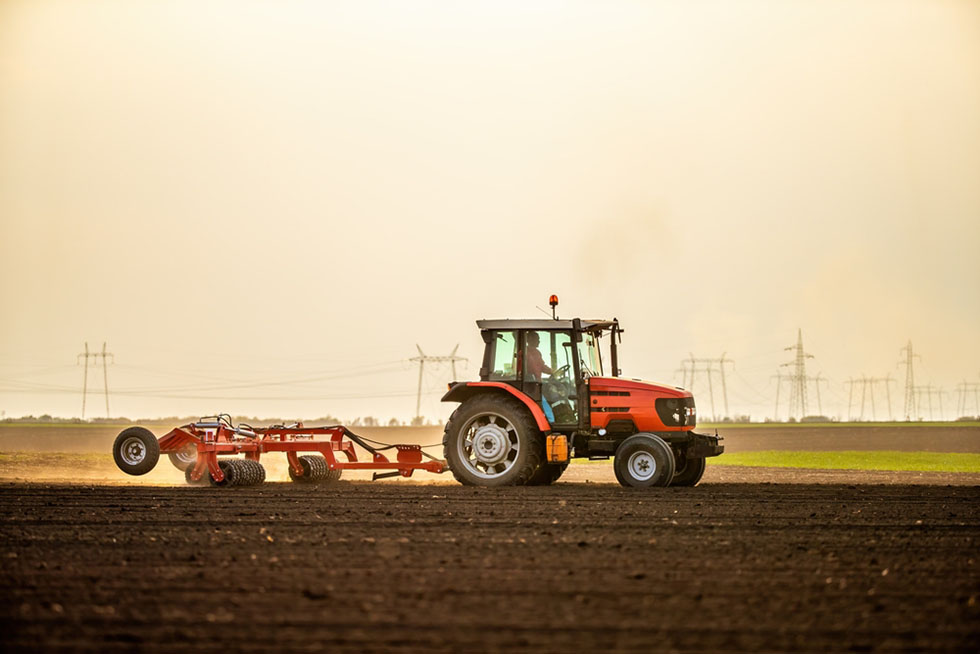Off-Road Diesel vs. On-Road Diesel: What’s the Difference?
Jul 18th 2024

Diesel makes the global supply chain go around. It’s the only fuel source with the efficiency and stability needed to haul thousands of pounds of cargo across the U.S. and beyond. It delivers packages and raw materials, safely transports passengers and powers heavy-duty construction and agricultural equipment on-road and off. However, taxes, fees, distribution and other considerations vary depending on the application. Learn about the differences between off-road diesel vs. on-road diesel to better maintain your fleet or truck.
All About Diesel
All diesel fuel, on-road and off, is made from crude oil or biomass. Petroleum refineries supply most of the diesel fuel consumed in the U.S. Each 42-gallon barrel of crude oil contains roughly 11 to 12 gallons of diesel fuel. Biomass-based diesel fuel, or biodiesel, is made from renewable, biodegradable materials like vegetable oils and animal fats. It’s more sustainable and less harmful to the planet than crude oil. However, most engines don’t run on 100% biodiesel. It’s often blended with diesel fuel, with B5 containing 5% biodiesel and B20 containing 20% biodiesel.
The Environmental Protection Agency (EPA) says it’s safe to use B5 in any diesel engine, including pickups and heavy-duty haulers, but the agency recommends checking your owner’s manual for more information. In 2006, the EPA limited the concentration of sulfur, a known carcinogen, in diesel fuel to 15 parts per million or less. Today, all on-road diesel fuel is ultra-low-sulfur diesel. According to the U.S. Energy Information Administration, most off-road vehicles use ULSD.
Diesel fuel is more efficient than gasoline. It packs more energy into each molecule to maximize torque and horsepower. It’s also more stable because diesel engines use compression and heat to trigger internal combustion instead of spark plugs, which makes it ideal for long-distance hauling and public transportation.
Modern engines use sensors to monitor and adjust fuel, oil and air pressure based on the number of rotations per minute (RPM) to deliver the necessary power while increasing fuel efficiency. Learn about the s ymptoms of a bad fuel pressure regulator to get the most out of every gallon.

On-Road Diesel
On-road diesel is meant for diesel vehicles that drive primarily on paved roads, including public streets and highways. It pours clear and is sold at most gas stations in the U.S. This type of fuel is typically used for transporting goods or passengers. It’s taxed by the state and federal government, with levies varying by state. These fees support road construction and maintenance. Imposing the tax at the pump limits the tax burden to drivers. The more you use public roads and streets, the more you’ll pay to support them.
Types of Vehicles:
- Pickup trucks
- Buses
- Vans
- Semi-trucks
When to Use On-Road Diesel
You should use on-road diesel when driving a private vehicle that is not designed for public applications, regardless of whether you plan to go off-road. Many consumer diesel pickup trucks have off-road capabilities, but that doesn’t mean you can use off-road diesel.
Off-Road Diesel
Off-road diesel is meant for public and commercial vehicles that travel off-road. It’s dyed red to make it easy to distinguish from on-road diesel. This fuel type isn’t taxed because these vehicles aren’t using or damaging public infrastructure. Waiving these fees also supports farmers and contractors who support the economy.
Red-dyed diesel fuel costs 30 to 80 cents less per gallon than gas. It’s commonly sold in bulk to private companies and organizations and is available at select fueling stations, usually those that service commercial and agricultural industries.
Types of Vehicles:
- Tractors
- Forklifts and loaders
- Construction vehicles
- Generators
- Gators and utility terrain vehicles (UTVs)
- Government and military vehicles
When to Use Off-Road Diesel
You can use off-road diesel as long as you don’t drive on public roads. In some areas, you may need to register as a farmer, construction firm or member of a governmental agency to access this fuel. If you want to use off-road diesel but need to drive on public roads to reach a fuel station, filling up a portable can is legal as long as you don’t put the fuel in your tank. You can also have the fuel delivered to the construction site or farm.

Off-Road Diesel vs. On-Road Diesel: Differences and Similarities
On-road and off-road diesel share the same chemical properties but contain varying amounts of biodiesel and sulfur depending on where they’re sold. Some states mandate using B5 in off-road applications to reduce their use of crude oil. The only noticeable differences between the two are the price and color. Fuel quality varies based on age, storage conditions and temperature. Bad diesel fuel appears cloudy or separated with more opaque sections toward the top.
Both types of diesel gel in cold temperatures, making them harder to burn and move through the fuel system. When seasons change, most gas stations switch to a winter blend that flows easier and burns faster to prevent gelling. Extreme temperature changes can also lead to water separation in the tank, increasing the risk of oxidation. Storing fuel in a dirty container will also spread debris through the engine.
What Happens if You Put Off-Road Diesel on the Road (or Vice-Versa)?
It’s safe to use on-road diesel in an off-road diesel vehicle and vice-versa. Some agricultural and construction firms use clear diesel despite the added cost when red diesel isn’t easily accessible. However, using off-road diesel in an on-road vehicle can lead to a hefty fine.
The authorities regularly pull over drivers and test what kind of fuel they’re using by extracting a small amount from the tank if they suspect foul play. Expect to pay up to $10,000 in fines if you’re caught using red diesel fuel on a public road. Most gas stations also have enhanced security to track everyone using the off-road diesel pump. For sensible truckers, using off-road diesel on-road isn’t worth the risk.
Shop All of Our Diesel ProductsOff-Road Diesel Fuel System Maintenance
Your diesel fuel is only as good as your fuel system. Because of the harsh conditions they face, off-road vehicles often need more regular maintenance than on-road vehicles. They also regularly move heavy loads from rest, which can overwhelm the system. Instead of tracking the number of miles traveled, most drivers physically inspect and test the equipment before and after every shift.

You’re bound to kick up more dirt and debris off-road. Airborne dirt, dust and debris can get trapped in and around the vehicle and may even leak into the fuel supply. Thoroughly clean the exhaust and under the hood to prevent rust. Wipe down the engine, battery terminals and radiator to let hot air escape. Driving through water and mud can clog the exhaust, which prevents burnt air and fuel from escaping. This can back up the engine and clog the filters with excess debris. Replace your fuel, oil and air filters regularly to keep the system clean. Too much dirt will clog the wire mesh, starving the engine. The fuel needs to reach a certain psi to burn thoroughly. Monitor fuel pressure using the sensor to see if psi levels are within the recommended range. Particles can clog the fuel pump, cutting off the fuel supply. If the pressure is low, find a new fuel pump for diesel fuel based on your make and model.
Debris can also leak into the fuel injectors, clogging the nozzle, which sprays the fuel as a fine mist. Overheating can also burn the nozzle head, altering the fuel spray. If the pressure remains low, replace your diesel fuel injectors to improve efficiency.
Storing fuel and oil onsite can increase the risk of contamination. Many off-road vehicles also spend the off-season in storage, leaving fuel and oil to sit for months at a time. Starting the engine after a long recess can spread water and debris. Change the oil and fuel and flush the system to remove any debris that may have accumulated before the start of the season.

On-Road Diesel Fuel System Maintenance
On-road vehicles typically travel longer distances and have more miles than off-road diesel vehicles. They operate and haul at a wide range of RPM. The injectors fire more often, which can increase the risk of failure. Monitor your fuel pressure and mpg ratings at different speeds to see if the engine is losing efficiency. You need to replace your fuel system parts and filters at regular mileage intervals to improve performance and efficiency. Fleet managers often develop strict maintenance schedules for on-road vehicles based on the distance traveled. Older models tend to need more frequent check-ups as their parts age.
Oil is reused more in on-road vehicles. It lubricates parts and pressurizes the fuel before it’s injected. Recirculating poor-quality oil on a long trip can spread debris and clog passageways, reducing fuel pressure. Poorly lubricated gaskets, seals and O-rings can break due to excess pressure. Change your oil every 3,000 miles to help your engine withstand higher speeds.
On-road diesel engines need regular turbocharger maintenance to accelerate quickly. The turbocharger forces more air into the engine to burn more fuel and generate more power. Debris can clog the air intake valve and damage the turbine that pressures the air. Monitor your engine boost time to see if the turbo is delayed.
When operating at high speeds, diesel vehicles use passive regeneration to clean the diesel particulate filter. It occurs every 300 miles or when soot levels reach 40% to 45%. Taking your truck on short trips and sticking to low RPM can prevent passive regeneration. Maintain the diesel particulate filter regularly by using the active regeneration feature. You can also travel on the highway every few hundred miles or have an auto shop perform forced regeneration to prevent clogs.
Watch for smoke from the radiator due to overheating when driving or towing long distances. Smoke will also come from the exhaust when coolant and oil leak into the fuel. Listen for a loud banging when starting the engine or accelerating, which usually means a part has come loose. A grinding often means certain parts don’t have enough lubrication. Hissing can indicate a leak or turbo malfunction.

Using the Right Diesel Fuel: On-Road or Off-Road Diesel?
Diesel fuel is used for all types of commercial and private applications, but off-road diesel is only meant for vehicles that don’t drive on public roads. Pickup and semi-truck drivers use on-road diesel and pay more taxes than farmers, builders and government employees to support highway construction and maintenance.
Using off-road diesel in off-road government, utility and agricultural vehicles saves money. However, driving on the street or highway with red diesel in your tank will incur a steep fine even if you intend to drive off-road. Check your local and state requirements for using this fuel to see if your business or application qualifies.
If you’re not sure how to get off-road diesel to your off-road worksite or property, you can always have your fuel delivered or use an on-road vehicle to transport and fill a storage container with off-road diesel.
All diesel fuel systems need regular maintenance regardless of how and where they’re used. Fuel can be a conduit for dirt, debris and rust, clogging vital passageways and reducing fuel efficiency. Use these considerations to optimize the performance of your on-road and off-road equipment.
Image Credits
Castro Carvalho/Shutterstock.com
suyoto suyoto/Shutterstock.com
Vitpho/Shutterstock.com
Skynight87/Shutterstock.com
Funtay/Shutterstock.com
Hasan Serhat Bozkurt/Shutterstock.com
Christina Hemsley/Shutterstock.com
Irene Miller/Shutterstock.com
WR7/Shutterstock.com
oticki/Shutterstock.com
